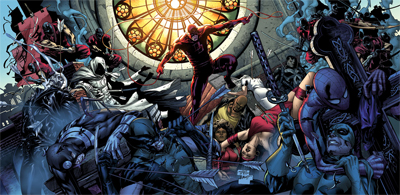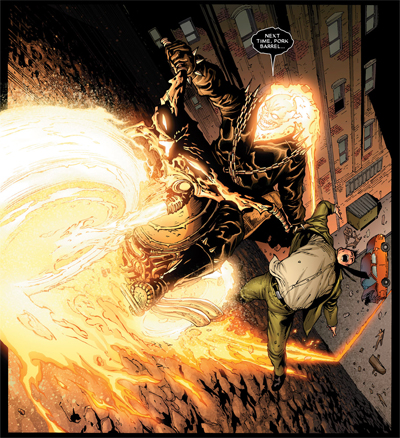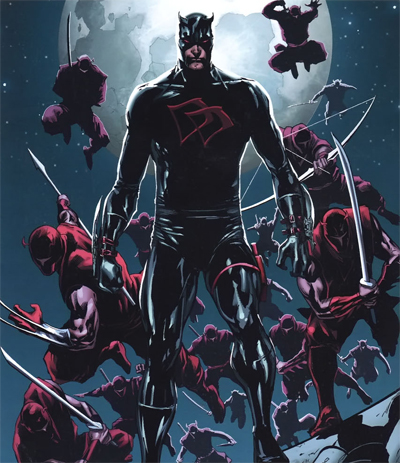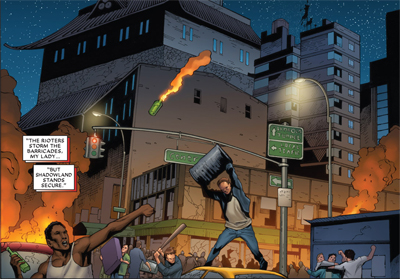This April, to celebrate the release of The Amazing Spider-Man 2, we are taking a look at some classic and modern comics featuring Spider-Man (and friends). Check back daily for the latest review.
Shadowland is a disappointing climax to a wonderful decade of Daredevil. From the moment that Kevin Smith launched the second volume of the character through to the end of Ed Brubaker’s run, the Man Without Fear enjoyed a wonderfully consistent run of stories including runs from some of the best writers and artists working in comics, pushing the character in bold new directions and well outside his comfort zone.
Shadowland has a lot of problems, but the most obvious is that it betrays its central character. Matt Murdock is one of the most fascinating protagonists in comics, a proud (and occasionally arrogant) individual who might have the best of intentions but isn’t always able to make the right choices. Watching Murdock deal with his own mistakes and setbacks was a pretty compelling hook, as the comic pushed its protagonist into increasingly uncomfortable positions.
Unfortunately, the same cannot be said for Shadowland. Despite an interesting premise, it all falls apart when it decides that “a demon did it” is an acceptable explanation for Murdock’s latest errors in judgement.
To be fair, maybe Daredevil isn’t suited to gigantic crossovers. Daredevil has always been something of a fringe franchise, and the second volume of the comic was often spared from the numerous line-wide crossovers that swept through the Marvel Universe. Daredevil wasn’t drawn into Civil War or World War Hulk or Secret Invasion or anything quite like that. It was allowed to tell its own story in its own way.
Shadowland is a different beast entirely. It’s very much a crossover that exists between a particular brand of books, the “street-level” heroes. Aside from the main five-issue series and the tie-in issues of Daredevil, the comic tied into on-going series like Thunderbolts and launched a number of one-shots and miniseries involving characters like Moon Knight, The Punisher, Power Man and The Amazing Spider-Man. It might not have been Fear Itself in terms of scale, but it was still a rather large event.
And events come with certain demands. The demands include scale and bombast, as well as scope. The action needs to be larger and the pool of characters involved needs to be wider. There’s really no way to have a properly intimate “event” comic, given all the editorial demands that need to be met. Characters show up simply because they are popular and might boost sales or because they are unpopular and need sales boost.
Reading Shadowland, there’s a sense that author Andy Diggle might be aware of the absurdity of his situation. Wolverine joins the story in the fourth issue, despite the fact that he has no real history with Daredevil. The character even gets his own variant cover, because that’s what sells comics. Never mind that he’s joining an ensemble that generally has much stronger ties to the Daredevil mythos and which fits a lot more comfortably within the framework of the event.
“Wolverine,” Elektra remarks, finding his presence as strange (and maybe even as cynical) as the readers. “What are you doing here?” Wolverine offers, “Let’s just say me an’ the Hand, we got history.” Never mind that he’s referring to Enemy of the State, a storyline that also heavily featured Elektra as a supporting character. It seems a little surreal that Wolverine has just invited himself into somebody else’s story. Captain America and Thor and the rest of the Avengers don’t seem too bothered.
Comic book events run on their own absurd internal logic – internal logic that feels rather at odds with the intimate psychological drama that made the second volume of Daredevil so effective. Bendis and Brubaker acknowledged the wider tapestry of the marvel Universe, occasionally drawing in guest stars for the comic, but they kept everything fairly grounded. All of a sudden, Murdock is building giant ninja headquarters in Hell’s Kitchen and getting visits from the Spirit of Vengeance.
Even the character dynamics don’t feel right. The heroes of Shadowland find themselves teaming up with the Punisher to fight the Hand. Never mind that Frank Castle is hardly on the best of terms with most heroes, he is a wanted mass murderer. And yet nobody seems to bat an eye about working with Frank Castle to bring down Daredevil. Misty Knight even calls attention to how weird this team-up must be, pointing out that the group should probably try to arrest Castle. They never do.
Similarly, events require a sort of simplicity and bombast that feels at odds with the strengths of the run of Daredevil that led up to Shadowland. Most of these big comics require lots of action and clear-cut good guys and bad guys. In contrast, the beauty of Bendis and Brubaker’s Daredevil has been watching Matt Murdock agonising over the right moral decision and often failing to identify or follow through on it. There are tough questions asked about Murdock’s decisions – his readiness to lie to protect his identity, his reluctance to ask for assistance, his stubborn prideful insistence on carrying on.
Instead, Shadowland is pretty clear cut. Matt Murdock commands a legion of deadly ninja. He kills an unarmed man at the climax of the first issue. He then attacks a bunch of his friends who just want to find a peaceful resolution to the current the crisis. Matt Murdock is the bad guy in this. He’s the villain. He’s a clear-cut supervillain. He even gets a snazzy black uniform to help the readers recognise him as such.
Again, it seems like Diggle is acutely aware of how awkwardly patronising this “evil costume switch” must be. Throughout the comic, various characters draw attention to it. “Nice duds,” Bullseye remarks. Spider-Man introduces himself into the action by offering some friendly advice, “That whole black costume thing? Never ends well. Trust me on this.” There’s no attempt the rationalise the costume change in the comic either. Given the Hand dress in red, surely Matt’s old uniform was fine?
(Throughout Shadowland, Diggle tries hard to mitigate against all the clichés by drawing attention to them, as if hoping the audience might laugh them off and play along. In the first issue, Bullseye fakes a seizure to escape from custody. “Are you out of your mind?” one guard asks. “He’s faking –!” And yet they unlock him, and then he escapes. The problem is that Shadowland isn’t smart or fun enough for the audience to want to buy into these tired old comic book conventions.)
It’s a shame, because there’s actually room for an interesting story here. Sure the “superhero tries to impose his will on the world” is something of a genre staple, but it might have been fun to see Matt Murdock come into conflict with his old friends after honestly and sincerely trying to impose order on Hell’s Kitchen. If Matt had made that decision of his own free will and committed to that path, the conflict could have been interesting and genuine.
After all, given how many people Bullseye has murdered and how readily he escapes from custody, it’s not unreasonable that Matt could decide to kill him. What then? How would the heroes have reacted to a cold-blooded murder of such a violent individual? There’s an interesting idea – a coldly rational Matt Murdock who has decided that he has had enough of Bullseye murdering people with impunity, and decides to end his reign of terror.
This would raise all manner of uncomfortable questions, as Diggle alludes to early in the crossover. “I guess all of us have blood on our hands,” Danny Rand reflects. “Like, how many nameless Hand ninja or Hydra goons have we taken out over the years…?” It would ask whether there are double-standards in effect, and how far is too far in the pursuit of public safety. Had Matt Murdock simply impaled Bullseye and the event developed organically from there, it might have been interesting.
“It may not be pretty,” Iron Man muses in the first issue, “but Daredevil’s ivory tower at least tells the people Hell’s Kitchen that their hero’s still watching over them.” There’s a philosophical question as to whether it’s possible to construct a totalitarian regime that could be benevolent – about whether an inherently evil method can be applied to receive a morally acceptable result. Given how ineffective the Avengers had been up to this point, it would certainly make a fascinating debate.
Instead, Shadowland follows the path of least resistance. It makes it quite clear that Matt Murdock is possessed by an evil demon at the behest of “a secret cadre at the heart of the Hand.” As Izo notes, without a hint of irony, “… and soon its ridiculously evil power will envelop the world.” This is all established in the opening sequence of the comic, just in case there could be any ambiguity. As soon as the heroes arrive to talk with Matt, the situation escalates. By the penultimate issue, Matt is physically transforming into a demon.
“The age of man shall end — and none be spared but Snakeroot!” the Hand vow, in a scene which establishes that Shadowland really belongs to an altogether more generic genre than the Daredevil comic it ties into. This is another “end of the world” comic book event involving some larger-than-life threat that poses a risk to all life on the planet, at the very least. This is not what made Daredevil such a successful comic, and using a story like this to cap off the run feels like an error in judgement.
To be entirely fair, Diggle does try to make some nods towards the psychological drama associated with Daredevil. “He must damn himself,” we’re told – the Hand apparently cannot entirely corrupt Matt Murdock. That means he has to make those first steps himself. The comic implies that Matt made his own decision to murder Bullseye, but it’s somewhat ambiguous. After all, it isn’t Matt’s first morally questionable decision, and he was psychologically weakened longer before he accepted command of the Hand.
More than that, though, the fact that the whole thing escalates to the point where “Matt Murdock physically transforms into a devil” means that any dramatic weight associated with the murder of Bullseye evaporates by the end of the miniseries. The action becomes a footnote rather than a focal point. That’s probably the biggest problem with Shadowland – Matt Murdock’s murder of Bullseye should be the biggest moment in the miniseries, the piece that everything pivots around. Instead, it’s just a jumping off point into a generic possession story.
It’s all so rote and familiar that the comic just sort of coasts through its drama. The absurd character beats and plot revelations are just… there. It doesn’t matter that they are contrived or that they don’t make sense or that they are awfully convenient. When the Kingpin is able to win over Typhoid Mary by use of “a three-word trigger phrase that unlocks he secret fourth personality”, there’s really no point trying to make sense of all of this. Shadowland has devolved from a story into a set of editorial directions.
As such, it’s all a little generic and boring – which feels like a disservice to what had been a pretty spectacular decade for the character. The absolute best thing that can really be said about Shadowland is that it fills the space between Ed Brubaker and Mark Waid’s take on the character. And even that is just a statement of empirical fact.
Filed under: Comics | Tagged: Andy Diggle, Comics, crossover, daredevil, marvel, marvel universe, matt murdock, Shadowland |































Hey great review man. Just wondering if this is the Andy Diggle storyline with Billy Tan on Pencils from 2011 or the Arc from 2014 with Andy Diggle returning as writer
I didn’t know there was a 2014 arc with Diggle returning as writer. This was the event miniseries itself, as distinct from the main book itself.